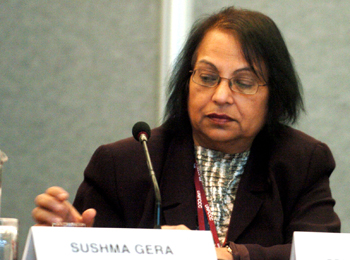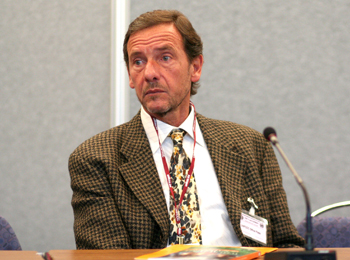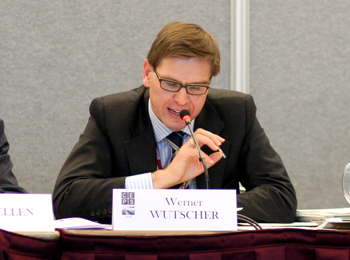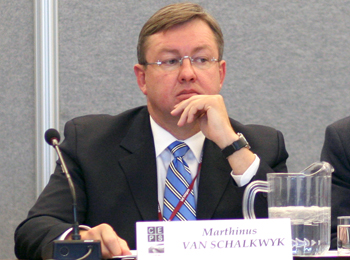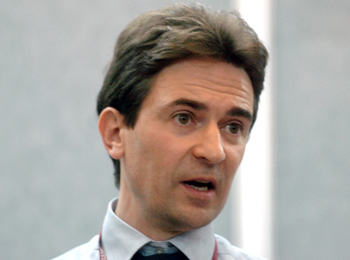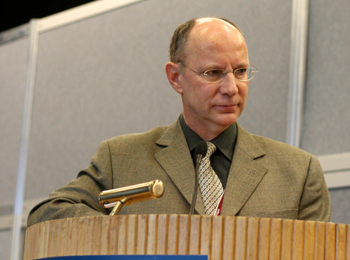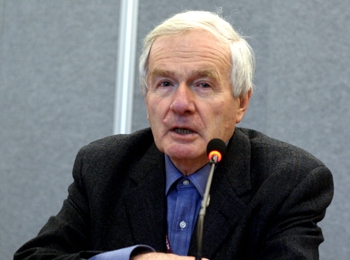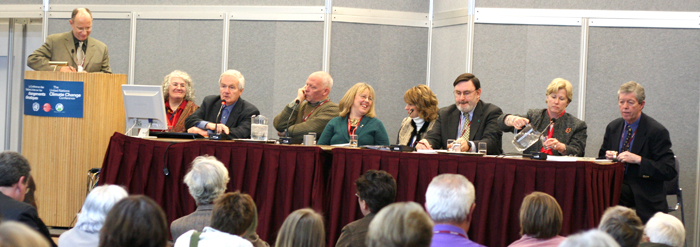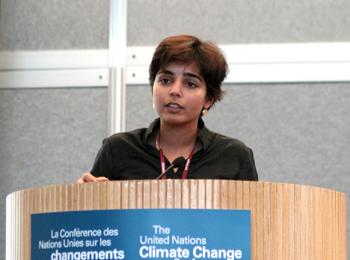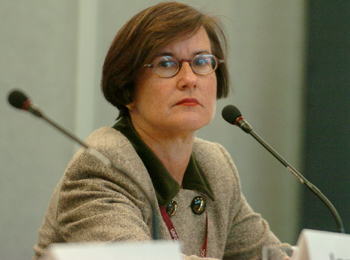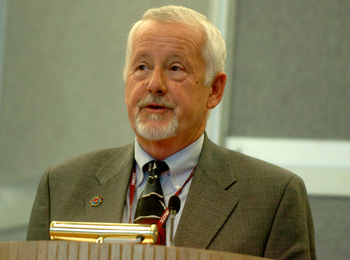 |
||
|
published by IISD, the International Institute for Sustainable Development
in cooperation with the UNFCCC Secretariat. |
|||
|
Special Report on Selected Side Events at COP 11 & Kyoto Protocol COP/MOP 1
|
|||||
| 28 November - 9 December 2005 | Montréal, Canada | |||||
|
Showcasing the CDM sustainable development and CERs Presented by the UNFCCC |
|||
|
Sushma Gera, CDM Executive Board (EB), listed some improvements in the management plan of the CDM EB, including the creation of a registration team, a pre-assessment stage, and an executive committee. Richard Kinley, UNFCCC Secretariat, noted that 41 CDM projects have been registered and over 500 are in the pipeline. He hoped the COP will send a positive signal to carbon markets for the post-2012 period. Hirofumi Kazuno, Kansai Electric Power Co., representing the e7, and Karma Teshering, Ministry of Trade and Industry, Bhutan, outlined the cycle of a project which aims to construct a micro-hydro power station to support rural electrification in rural Bhutan. Kazuno called for simplified certification procedures to reduce transaction costs and promote similar types of projects. Eduardo Reyes, National Authority of Environment, Panama, described a hydroelectric project promoted by Unión Fenosa, which has committed to build project infrastructure. He noted that some of the CER income will help recover flora and fauna together with community groups and fund adaptation initiatives. Iftekhar Enayatullah, Waste Concern, presented a landfill gas extraction and utilization project in Dhaka, Bangladesh, funded by World Wide Recycling, explaining it collects methane gas from waste dumping and generates 3 to 6 MW. Sergio Vives, Agrosuper, described a methane capture and combustion project from swine manure treatment in Chile, co-funded by Canada and Japan. He underscored that patience and learning from experience are key. Li Liyan, Office of National Climate Change Coordination Committee, China, listed priority CDM areas, including energy efficiency, and methane recovery and utilization. She stressed that the project owner must be a wholly Chinese enterprise. José Miguez, Ministry of Science and Technology, Brazil, said 21 CDM projects have been approved and 28 more are in the pipeline, and mentioned the approval of a resolution by the CDM interministerial commission on afforestation and reforestation projects. Fransisco Avendano, National Council for the Environment, Peru, underscored that CDM projects should deploy proven technologies and must show social acceptance in the project area. Lwazikazi Tyani, Department of Minerals and Energy, South Africa, outlined the function of the designated national authority (DNA), and described sustainable development criteria for CDM project approval. Roger Peter, Pembina Institute for Appropriate Development, Shinichi Iioka, Institute for Global Environmental Strategies, and John Christensen, UNEP, presented the perspective of CDM capacity development partners. |
|||
|
|||
|
Wealth of poor nations threatened by climate change Presented by the World Bank |
|||
|
Sergio Jellinek, World Bank, introduced the book titled “Where is the Wealth of Nations? Measuring Capital for the 21st Century” published by the World Bank.
Ken Newcombe, World Bank, said analysis of natural capital accounting in economic growth patterns has been inadequate. He stressed the need to consider the effects of climate change on natural capital and ecosystem service payments for managing natural resources. Kirk Hamilton, World Bank, said wealth has a number of components such as natural, human and institutional capital. He noted that the wealth of many low income countries is declining, that cropland and pastureland is their most important wealth, and that there is a need for better management of natural capital. Atilio Savino, Secretary of Environment, Argentina, underscored that traditional economies produce at the expense of natural and human capital which leads to poverty, and indicated that Argentina is taking environment into consideration in its national accounts. Discussion: participants questioned the book’s consideration of the impact of climate change on the wealth of nations, and the use of market prices in valuing natural resources. |
|||
|
|||
|
Adaptation for developing countries Presented by the Ministry of Environment and Forests and The Energy and Resources Institute, India |
|||
|
Rajendra Pachauri, The Energy and Resources Institute (TERI), emphasized that tackling future risks involves addressing both today’s vulnerabilities and planning for future impacts, stressing that financing adaptation should be carried out at multiple levels.
Bonizella Biagini, GEF, underlined that GEF plays a significant role in supporting adaptation, noting that the new Least Developed Countries Fund (LDCF) and Special Climate Change Fund (SCCF) funds will support the additional costs of activities that increase adaptive capacity over a development baseline. Ian Burton, independent scholar, Canada, highlighted the presence of an adaptation deficit, noting the need for an adaptation protocol to address adaptation issues systematically. Saleemul Huq, International Institute of Environment and Development, emphasized the importance of considering the millions of poor who bear the greatest burden of climate impact, noting that the GEF funding mechanisms need a simplified structure. Neil Leary, International Systems for Analysis, Research and Training (START), said developing countries should take ownership of their adaptation agenda. Ian Noble, World Bank, noted that there are many excellent research facilities in developing countries that can be enhanced further. Prodipto Ghosh, Ministry of Environment and Forests (MOEF), India, noted that development is the best adaptation strategy for developing countries. Discussion: participants discussed the relative responsibilities of developed versus developing countries for funding adaptation. |
|||
|
|||
|
Improving the functioning of the CDM Presented by the Centre for European Policy Studies |
|||||
|
Christian Egenhofer, Centre for European Policy Studies, presented “Improving the CDM”, a report from the European Climate Platform, noting that concern over CDM capacity fails to recognize other available alternatives, and that CDM is a work in progress. Werner Wutscher, Federal Ministry of Agriculture, Forestry, Environment and Water Management, Austria, emphasized the role played by NGOs, and that CDM is a cornerstone of the Kyoto Protocol. Marthinus van Schalkwyk, Minister of Environmental Affairs and Tourism, South Africa, stressed that CDM is fundamental to the UNFCCC and Kyoto’s architecture, and called for sending a clear signal to the carbon market and minimizing transaction costs to bring small business on board. Dirk Forrister, Natsource, presented the private sector’s perspective on CDM, noting that entry into force of the Marrakesh Accords may provide the needed market certainty. He emphasized a practical approach to seeking additionality and said the EB needs to attract new expertise with regulatory experience, and move from policy making to an executive role. Jürgen Salay, European Commission, stated that the EU is a strong market driver, and hoped that current CDM negotiations will yield secure funding for the CDM, and strengthen CDM governance. Discussion: participants questioned the ability of CDM projects to meet expected demand and discussed the inclusion of afforestation and reforestation. |
|||||
|
|||
|
Shedding Light on CO2 abatement Presented by the International Energy Agency |
|||||
|
Richard Baron and Cédric Philibert, International Energy Agency (IEA), highlighted successes of emissions trading systems, but noted the price discrepancy between the Chicago Climate Exchange and EU ETS. They emphasized reaching all sectors, and noted that developing countries have a high emissions-to-GDP ratio, even though per capita emissions are low. They highlighted emission reduction opportunities, including flexible targets to encourage broader participation, and said market imperfections must be addressed. |
|||||
|
|||
|
Our changing atmosphere: Implications for Global Security Presented by the World Council of Churches and the Commons Group |
|||
|
David MacDonald, Concordia University, called for dialogues with parliamentarians about values and responsibility.
Charles Caccia, University of Ottawa, said some government officials are sensitive to ethical argument, and emphasized that one can be ethical without being religious. Laura Broughton, Ministry of Environment, Ontario, announced that Ontario plans to close all coal-powered power plants by 2009. Christine Milne, Tasmania Senator, Australian, stated that all decisions are ethical and that choosing to ignore climate change is a choice that threatens others. Peter Timmerman, University of Toronto, expressed concern about the destruction of spiritual traditions of traditional societies. Bill Somplatsky-Jarman, Presbyterian Church, US, called for solidarity, and said we have a responsibility to articulate concerns of those who are unable to speak for themselves. Joy Kennedy, Kairos, Canada, described “Greening Sacred Spaces,” an initiative designed to make churches more environmentally friendly. |
|||
|
|||
|
Launching the GHG Protocol for project accounting Presented by the World Business Council for Sustainable Development |
|||
|
Björn Stigson, World Business Council for Sustainable Development (WBCSD), described the catalyst behind the Protocol’s creation, and highlighted WBCSD’s partnership with the World Resources Institute (WRI).
Mahua Acharya, World Business Council for Sustainable Development (WBCSD), presented the GHG Protocol for Project Accounting, a tool and guidance manual for quantifying and reporting projects emission reductions. Derek Roekhoff, WRI, described the various parts of the Protocol. Michael Lazarus, Stockholm Environment Institute, commented on the process behind the Protocol’s development, highlighting stakeholders’ involvement. Dwight Domorais, Lafarge, described ways the Protocol helped clarify GHG project accounting and design while developing a CDM project in Malaysia. Bruno Vanderborght, Holcim, hoped the Protocol, like the GHG Protocol Corporate Accounting and Reporting Standard, would facilitate the development of standardized baselines for the cement industry. Einar Telnes, DNV, commented on how policy considerations may be relevant to GHG accounting decisions. In noting the complexity of designing GHG programs, Rob Fowler, New South Wales GHG Abatement Scheme, said the Protocol is an excellent starting point. Jeff Fielder, Natural Resources Defense Council, said the Protocol’s requirements and principles assist NGOs in reviewing the credibility of GHG reduction projects, and highlighted it does not include sustainable development criteria. |
|||
|
|||
|
Lessons from the Real-Life Laboratory of California: Voluntary GHG Reporting Presented by the California Climate Action Registry |
||||
|
Diane Wittenberg, California Climate Action Registry, opened the side-event, noting that California Governor Arnold Schwarzenegger set stringent GHG reduction targets in June 2006. Alan Lloyd, California Environmental Protection Agency, noted that California is the twelfth highest GHG emitter by jurisdiction in the world and that the California Climate Action Plan Registry was established to reduce California’s emissions. He said the cornerstone of the reductions targets include increased renewable energy, energy efficiency and conservation standards. James Boyd, California Energy Commission, noted that California’s high population increase in the last two decades and commensurate automobile use accounts for its high GHG emissions, and said that Governor Schwarzenegger’s targets imply a reduced reliance on fossil fuels, increased use of alternative fuels, including biofuel and bioenergy and that energy imports must be produced as “cleanly” as in-state energy. Dian Grueneich, California Public Utilities Commission (CPUC), re-emphasized California’s intention to procure “clean” energy imports from surrounding states, noting that this will be controversial. She also said that energy efficiency will be the number one resource for meeting California’s energy needs in the coming years. The ensuing discussion focused on how firms are encouraged to join the registry, the number of “Hummers” owned by Governor Schwarzenegger, and battery powered automobiles. One panelist noted that California probably has both the highest number of Hummers and Prius’ per capita. A second panel was then convened in which members of the registry, including CTG Energetics, the Allied Community College District, Sacramento Municipal Utility District, Calpine Corp., and Bentley Prince Street, discussed their reasons for joining the registry. |
||||
|
|||
|
||
|
Click the above button to go back to our ENB main coverage
|
||
|
|
|
|
|
||
|




